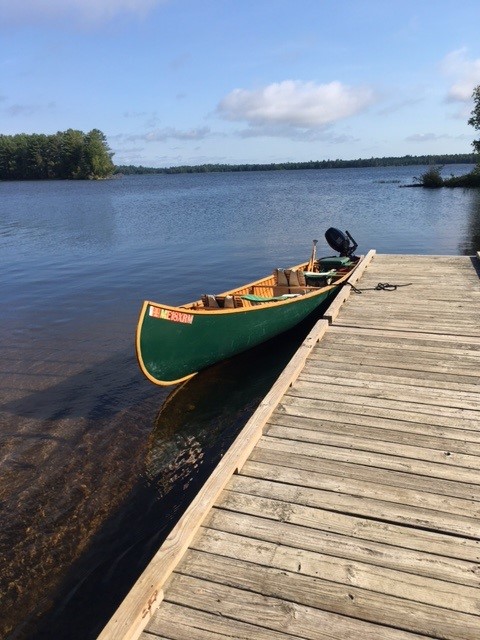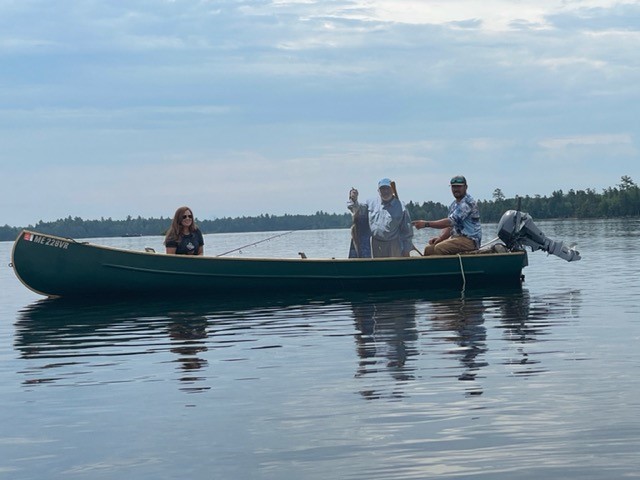RiskBridge Advisors – Camp Kotok 2022
August 12, 2022
CAMP KOTOK 2022
Camp Kotok is an invitation-only gathering of prominent economists, asset allocators, strategists, traders, bankers, scientists, policymakers, diplomats, and journalists. The event has taken place for 20 years in early August in the Downeast Lakes region of Maine near the Canadian border. It is a mash-up of an economics conference and adult summer camp with several days of fishing and fellowship.
Generally, each day starts with a question over breakfast, then two campers and a highly skilled guide spend several hours in a canoe chatting, solving world problems, and fishing (sometimes catching, too).
Discussions are held under Chatham House Rules, where participants are free to use the information received, but neither the identity nor the affiliation of the participant or speakers may be revealed without their express consent.
This year’s event was split into two separate weeks. COVID-19 health protocols were in place. I missed those who attended week two, but the smaller gathering allowed me to meet new friends and neighbors. There were deep discussions and debates on many topics, including the economy, markets, monetary policy, national defense, deglobalization, entrepreneurism, religion, motorcycle repair, and astrophysics.
TEN THINGS I LEARNED AT CAMP
1. Regime Analysis: Downturn
Campers generally agreed that U.S. real economic growth is decelerating, but the group was mixed on whether inflation has peaked. July core CPI came in unchanged to June at 5.9% y/y. Headline inflation came in better than expected at 8.5% y/y, “less hot” than June’s 9.1% y/y.
The National Federation of Independent Businesses (NFIB) survey shows that inflation and pricing expectations are declining, along with capital spending and investment plans.
One camper argued that the increase in demand-side economic policies and the decline in U.S. labor productivity sets a course for higher future inflation.
An entire generation of economists, portfolio managers, and investors have experienced years of 2% real U.S. GDP growth and 2% U.S. inflation (4% nominal). In 2021, the configuration was 5.7% growth plus 4.7% inflation (10.4% nominal). 2022 is on a path of 2.0% growth plus 8.0% inflation (10.0% nominal). Based on consensus expectations, 2023 could decelerate to 1.3% growth and 3.6% inflation (4.9% nominal).
Key Takeaways: In our view, the regime shift from “stagflation” to “downturn” is underway with decelerating growth and slowing inflation. Historically, the best-performing asset classes during a downturn regime include long-dated Treasurys, municipal bonds, defensive equities, and dividend payers (healthcare, staples, utilities, and REITs). During downturns, the worst-performing asset classes have been commodities, high yield credit, emerging market debt, and cyclical/high-beta stocks (energy, technology, industrials, financials). Past performance does not guarantee future results.
RiskBridge stands by its long-term assumption that the U.S. economic glide path through 2025 will be something like 1.5% real growth and 3.5% inflation (5.0% nominal).
2. Inflation Is Complicated
According to one money manager, inflation pressures were building before the pandemic as central banks have mispriced money for decades. Global labor demographics are inflationary. China and Russia actively deglobalizing are inflationary (and counter-cyclical). Inflation will take a long time to unwind.
Key Takeaways: We are focused on the rate of change, not the level. If we are right, the Fed rate hike cycle has further to go. If we are wrong, we think it’s likely because inflation and the Fed funds rate will be higher (not lower) than our base case. We believe speculators covering their short positions and investors jumping into this market in anticipation of a Fed pivot to a more dovish stance will be disappointed.
3. No One is Positioned or Prepared for 5% Interest Rates
The group was challenged to consider a hypothetical scenario of a flat U.S. yield curve at 5%. Investors don’t appear prepared for this possibility, which would likely generate more negative returns for stocks and bonds, as we saw in 1H 2022.
Key Takeaways: The probability of a 5% 10-year Treasury yield is greater than zero. This scenario may create material dispersion between equity and credit winners and losers and favor economic sectors where the return on invested capital (ROIC) exceeds the higher cost of capital. We believe infrastructure (transportation, digital and green) and biotechnology are two growth segments that could thrive in a higher interest rate environment.
4. World War III? Battle Over the Future Global Financial System
A former Fed official argued that global geopolitical conflicts should be viewed in the context of a war against the post-World War II structure where the U.S. dollar has served as the world’s only reserve currency. One way to dismantle the USD-based global trading system is by creating inflation through energy, food, and supply chain disruptions.
Key Takeaways: Russia and China have publicly expressed their desire to replace the 77-year-old global financial system and the strings attached to the U.S. dollar’s global reserve status. We believe the existing (Ukraine) and future (Taiwan) geopolitical conflicts should be viewed in the context of the desire of Russia, China, and Turkey to establish a new world order.
5. World War III? The Battle for Ukraine
Campers heard from a national defense expert. The expectation is that Russia’s “special military operation” in Ukraine will extend well into 2023 and perhaps longer. The Ukraine war is on day 168, compared to the Korean conflict, which lasted 1,128 days, and the Iran/Iraq war, which lasted 2,889 days. There’s an expectation that a negotiated peace will go through a start/stop process. Russia seems willing to sweep bad strategy under the carpet and replace it with old siege tactics that will draw out human and structural damage in a campaign of attrition. The U.S. defense industry has supported Ukraine, but not to the extent of the European defense industry. The inventory of Vietnam-era equipment is being depleted from U.S. stockpiles, so the need for U.S. defense manufacturers to boost production is limited. The opposite is true of European defense manufacturers, some of which have seen their stocks rise by 100% year-to-date.
A Yale University study finds that business retreats and sanctions are catastrophically crippling the Russian economy. Russia’s strategic positioning as a commodities exporter has irrevocably deteriorated, and Putin now deals from a position of weakness with the loss of its main markets. Russian imports have largely collapsed, and the country has lost companies representing 40% of its GDP, reversing nearly three decades worth of foreign investment and buttressing.
Key Takeaways: Why is Turkey still in NATO? The battle in Ukraine is going to be a long slog. Europe’s economic volatility will worsen before it improves; therefore, we expect capital market turbulence to persist. En route to Maine, I listened to an audiobook titled “The Guns of August” by Barbara Tuchman, initially published in 1962. The book centers around the first month of World War I, and in our view, offers a lot of similarities between Europe in 1914 and 2022. It’s a recommended read.
6. Deglobalization
Deglobalization is not a monolithic thing but a thousand incremental changes, starting with the decline in global trade, which peaked in 2008. U.S. and China decoupling is speeding up following Nancy Pelosi’s visit to Taiwan. Expect a wave of tough-on-China legislation after the mid-term election, which will widen the chasm between the U.S. and China.
Onshoring, reshoring, or nearshoring are the new buzzwords.
The construction of new manufacturing facilities in the U.S. has soared 116% over the past year, according to Dodge Construction Network.
Bloomberg reports that new aluminum and steel plants are going up in Alabama, Arkansas, and Kentucky.
Semiconductors are a global interdependency that can influence geopolitical events. In Phoenix, Intel is building two chip factories, and Taiwan Semiconductor Manufacturing is building one new factory.
The landmark, bi-partisan CHIPS and Science Act provides $53 billion in subsidies for U.S. semiconductor production and research and $170 billion for new regional technology hubs aimed at reducing long-term supply chain vulnerabilities for next-generation communications, computers, and pharmaceutical manufacturing.
The Chinese Embassy in D.C. criticized the legislation by calling it a “Cold War mentality.”
Key Takeaways: Deglobalization, like globalization, will generate “good” and “bad” interdependencies. In our view, slower growth in developed economies and China will drive deglobalization as much as geopolitical events. New U.S. business applications grew to 5.4 million in 2021 from 3.5 million in 2019 before the pandemic. Transportation/warehousing business growth is +101% (U.S. Census data). The top 5 states for new business growth are Mississippi, Louisiana, Georgia, Delaware, and Wyoming. Note: Delaware and Wyoming are favored jurisdictions for foreign entities setting up businesses in the U.S.
7. Kabuki Theater Inside the Eccles Building
It appears the Fed lost its independence as partisan politics seeped into the nomination process of the Federal Open Monetary Committee. Like the Supreme Court, we believe the Fed has become politicized from within. What’s left of Fed independence risks slipping away while the U.S. is in an economic war with China, Russia, North Korea, and Iran.
Q: What would allow a Jay Powell Fed to restore independence?
A: An surprise intra-meeting policy rate hike.
The July nonfarm payrolls (NFP) came in at 528,000, providing the Fed with all the ammunition needed to raise the Fed funds rate another 75 basis points at the September 21 meeting. The Fed may pause in November to give the mid-term election process some breathing space. One speaker suggested the 2y10y curve could go to -50bps and stay there.
Key Takeaways: Fed independence enables the “exorbitant privilege” of the U.S. dollar’s world reserve currency status. The internal politicization of the Fed has dire long-term consequences. I’d like to see that genie put back in the bottle.
8. Don’t Let a Good Crisis Go to Waste
During a discussion on inflation and monetary policy, fellow camper Marshall Stocker discussed the interdependencies between political institutions (democracy vs. autocracy), economic policy change, and investment outcomes. Marshall has published [1] extensively on this topic. As the co-head of the Emerging Markets team at Morgan Stanley Investment Management and formerly the Director of Country Research for Eaton Vance, he knows a thing or two about a good economic crisis.
Stocker’s research suggests that the quality of economic institutions explains a country’s asset valuations, and economic policy changes explain excess returns. However, the role democracy plays in improving economic policy and economic freedom[2] has changed over time. From 1970 to 2000, democracy had a significant favorable impact on economic freedom. Then something changed after 2000. In the last two decades, democracy contributed meaningfully to countries that began from a low point in economic freedom. For countries that started with high levels of economic freedoms (like the U.S.) in the last two decades, democracy contributed nothing and even reversed economic freedoms.
Key Takeaways: First, we’ve previously written about the continuous tug-of-war between capitalism (grows the pie) and democracy (divides the pie). Stocker’s research illustrates how democracy intensifies the reallocation of resources. We hope we are experiencing a cyclical tug of war where capitalism cedes ground to democracy and vice versa. A more disconcerting outcome will be if capitalism gets pulled across the line due to further weakening of U.S. economic institutions (Fed, Treasury, financial regulators).
Second, economic crises (banking, domestic debt, inflation) create windows of opportunity for country leaders to change economic policies, which reduce economic freedoms. This theory on steroids is found in the aftermath of the policy response to the Great Financial Crisis and the one-in-one-hundred-year global pandemic.
Thanks to Marshall Stocker for granting permission to use his name and cite his research.
9. Cyclical vs. Structural Changes
We’ve been using the same cycle analysis for decades, but traditional analysis may be useless in the context of monumental economic adjustments following the Great Shutdown of 2020 and the wake of $10 trillion of U.S. fiscal and monetary stimulus.
Key Takeaways: Important market indicators have lost their signal. Investment references are obstructed by the fog of policy responses to the global pandemic. In pilot speak, we’ve changed from visual flight rules (VFR) to instrument flight rules (IFR), but the altimeter and heading indicator aren’t functioning.
10. Investment Opportunities in Biotech
Over the weekend, the U.S. Senate passed the ironically titled Inflation Reduction Act (IRA), which includes $369 billion for renewable energy tax credits, $64 billion to extend Affordable Care Act subsidies through 2025, tax share buybacks starting in 2023, and allow Medicare to negotiate the price of prescription drugs and impose caps and rebates, including a cap on seniors’ insulin costs at $35 per month.
Big pharma’s pushback on the new law is that it will cost the industry $270 billion over ten years, negatively impact company cash flows, force the reduction of internal research & development, lower the supply of drugs needed in the market, increase uncertainty, and decrease innovation.
Key Takeaways: The Inflation Reduction Act title sounds promising, but we are skeptical that the IRA law will reduce inflation. We look for more mergers and acquisitions in the healthcare sector. New entrepreneurial biotechnology startups will drive research and development, filling the perceived R&D gap. RiskBridge sees this new wave of biotechnology companies as an attractive long-term investment theme.
This post originally published by RiskBridge Advisors’ RiskReport. Click here to view the original post.




Leave a Reply
You must be logged in to post a comment.